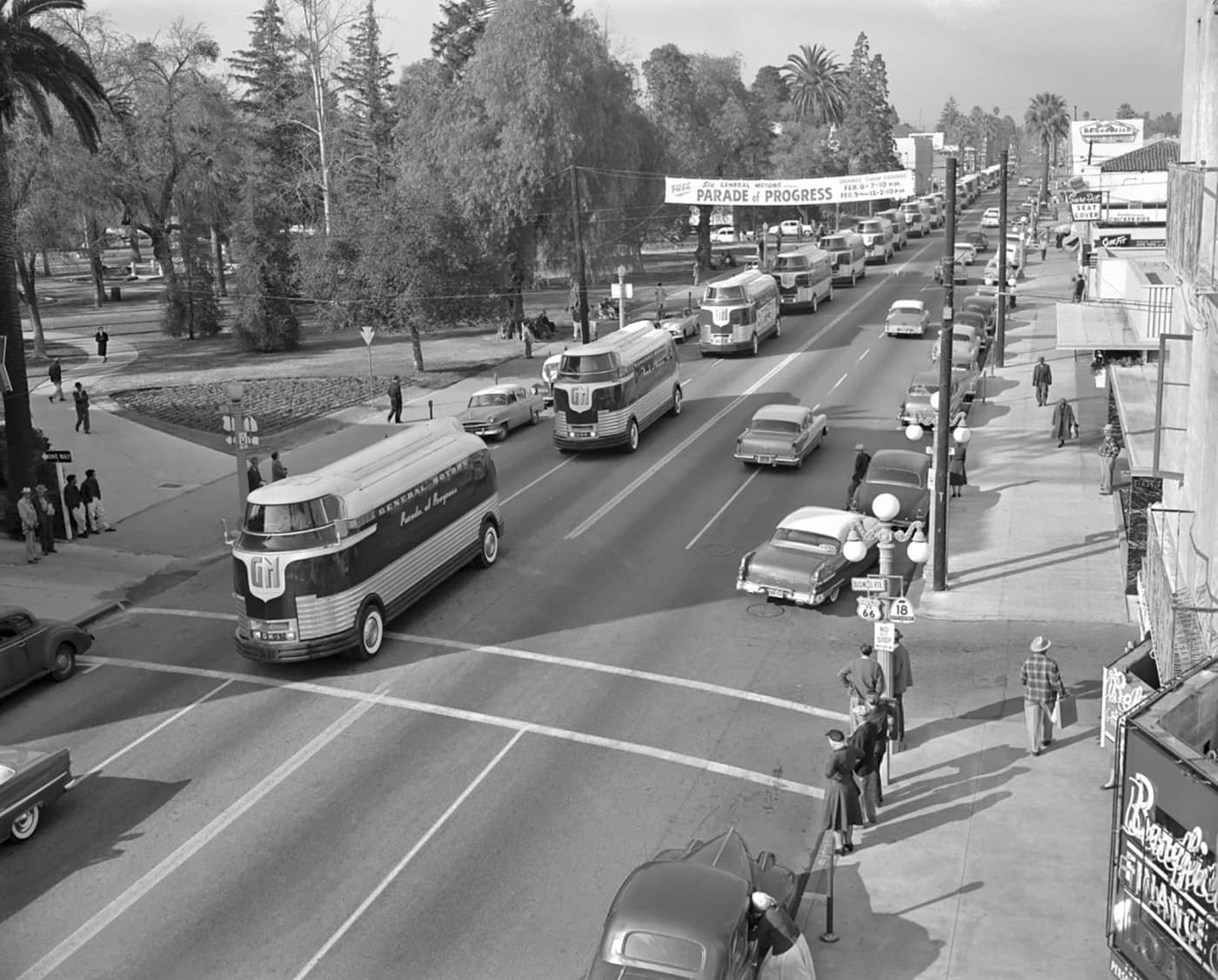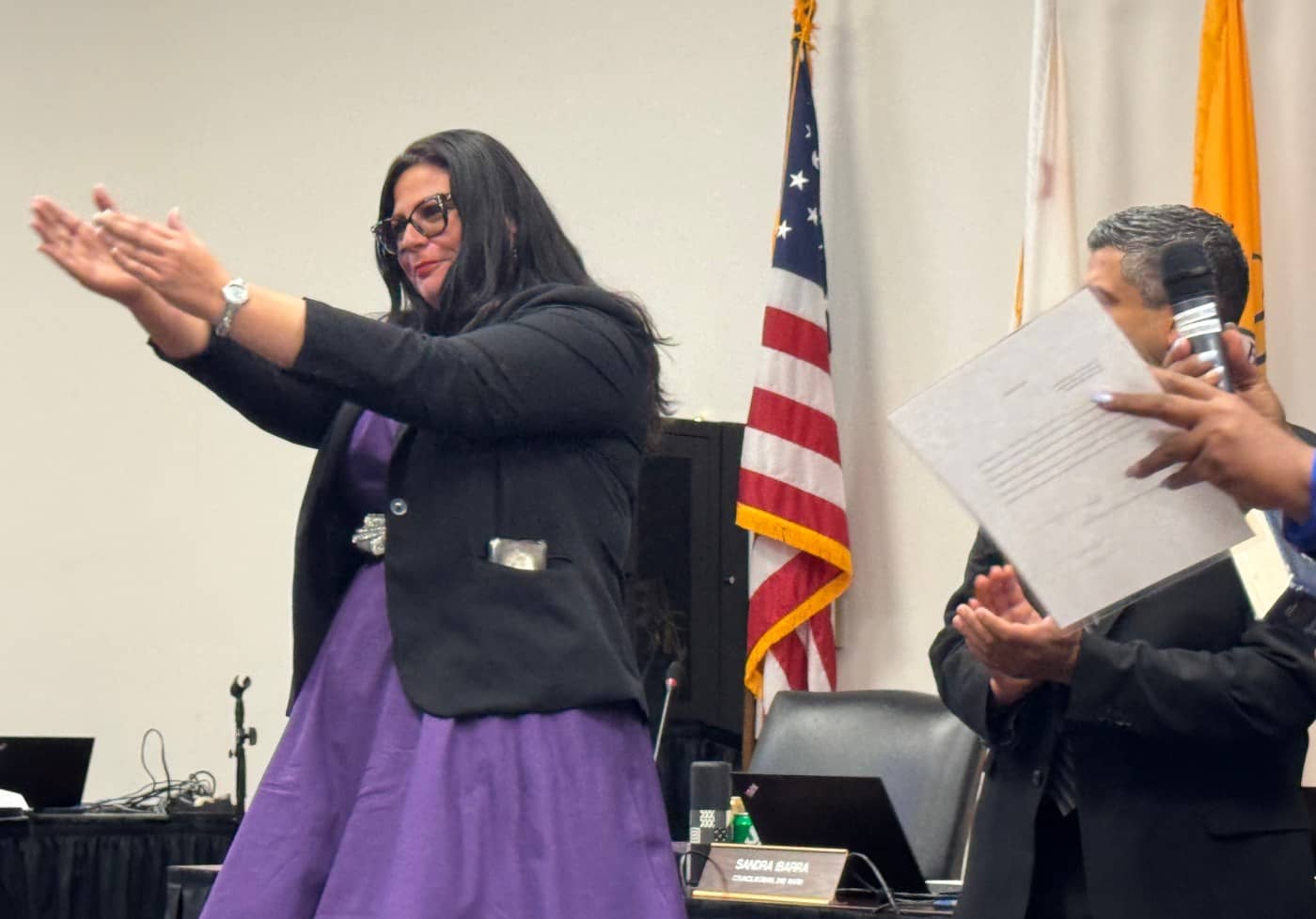The future rolled into the Inland Empire in February 1956, when General Motors’ fleet of ultramodern Futurliner vehicles led the “Parade of Progress” to the National Orange Show grounds in San Bernardino.
GM’s Parade of Progress was a rolling showcase of technology and self-promotion that included a 150-city tour of the United States and Canada. The circus-style caravan was transported by a fleet of support vehicles, and 12 unique Futurliners as stars of the show.
The Futurliner was part bus, part truck, and part classroom, all wrapped in a gleaming chrome, and steel wrapper. It was designed in the 1930s “Streamline Moderne” style that used horizontal lines, and curving forms to give the impression of aerodynamic sleekness.
Harley Earl, head of GM’s styling division was responsible for the look of the Futurliner, and the vehicle became one of the company’s most iconic.
Created for the 1939 New York World’s Fair, the Futurliners were became GM’s rolling ambassadors of science and education in 1940 and 1941. The Parade of Progress was interrupted by World War II, and it was resumed from 1953 to 1956.
The Parade of Progress was first launched in 1936 with a slightly less elaborate program that featured science exhibits carried in eight specially designed bus-style vehicles named “Streamliners.” This early version of the parade ran until 1940, and the Streamliners were replaced by Futurliners.
To carry out its mission as a traveling showcase, the Futurliner was given bus-sized dimensions and they weighed about 33,000 pounds. They were originally powered by a 4-cylinder GM diesel engine, with a 4-speed manual transmission.
Horizontal panels on the side of the vehicle opened up, revealing a science exhibit and a stage platform, complete with a loudspeaker sound system and custom lighting.
The Futurliner’s cab sat forward of the front axle, in the center of the vehicle, and the semi-circular windshield provided a 180-degree panoramic view for the driver.
San Bernardino was the 128th stop on the Parade of Progress tour, and nearly 7 million people had attended the moving classroom events by the time it reached San Bernardino.
Local newspapers ran full page articles and ads about the free exhibit, and they announced the tour would entertain its’ 7 millionth guest in San Bernardino.
A full accounting of the Parade of Progress’s route and activities was carried in the San Bernardino Sun on Feb. 7, 1956.
“The long caravan will stop on Mt. Vernon Ave. at Mill St. to pick up civic leaders and General Motors dealers at 2 p.m. The half-mile long convoy will then proceed north on Mt. Vernon to Base Line and turn right to E St. A local high school band will lead the caravan on E St. from 7th to the National Orange Show grounds.”
Futuristic vehicles and science displays weren’t the only things promoted at the event. GM also touted its specially designed and patented Aer-O-Dome tent that could seat 1,500 people. They claimed it looked like a “giant umbrella turned inside out” and a “dirigible balloon hanger.” A GM advertisement for the Aer-O-Dome said, “Never was there such a tent before – it may set a vogue in portable housing.”
The opening performance of the Parade of Progress was attending by 3,117 people on Feb. 8, at the Orange Show grounds.
Twenty-six educational and scientific exhibits displayed such marvels as “The Motor That Runs on Sunshine, Three-Dimensional Sound, Electronics-Microwave Magic, and Jet Engines and Rockets.”
The local GM dealers joined the event, and a special showroom was set up to display their new automobile lines.
More than 50,000 people visited the Parade of Progress display during its 4-day run at the Orange Show grounds, which ended on Feb. 12.
Mrs. Ralph Olsen of Riverside was named the 7 millionth visitor to the show, and she was presented with a new refrigerator.
The Parade of Progress wrapped up its final event in Spokane, Washington, on July 4, 1956, after reaching the 8 million visitor mark in that city. The caravan made its final journey to Detroit, where the exhibit was dismantled.
The extraordinary exhibit lasted 3½ years, traveled more than 18,000 miles, and performed in 148 cities in 35 states.
Ironically, GM ended its amazing Parade of Progress because of progress. External factors such as rising costs, diminishing returns, and the availability of mass marketing through TV led GM executives to cancel the program.
Today, nine Futurliners are known to exist. They have been preserved in a variety of conditions, and several have been restored to their original design. Various companies, museums, and private collectors own the vehicles, and they are scattered around the world.
Related Articles
‘Gone With the Wind’ had its first-ever screening in Riverside
Watchmaker designed and built sundial as a gift to Riverside
Items from Corona’s past sought for ‘show and tell’ event
Thousands of shoes left behind in dusty San Bernardino County ghost town
Elvis Presley returned to San Bernardino’s Swing for final time in 1974
Futurliner No. 11 was sold in 2006 and 2015 for an astonishing $4 million plus premium. Proceeds from the sale in 2015 benefited the Armed Forces Foundation.
In 2014, Futurliner No. 10 was selected for inclusion in the National Historic Vehicle Register and it is currently on display at the National Auto and Truck Museum in Auburn, Indiana.
Mark Landis is a freelance writer. He can be reached at Historyinca@yahoo.com.



